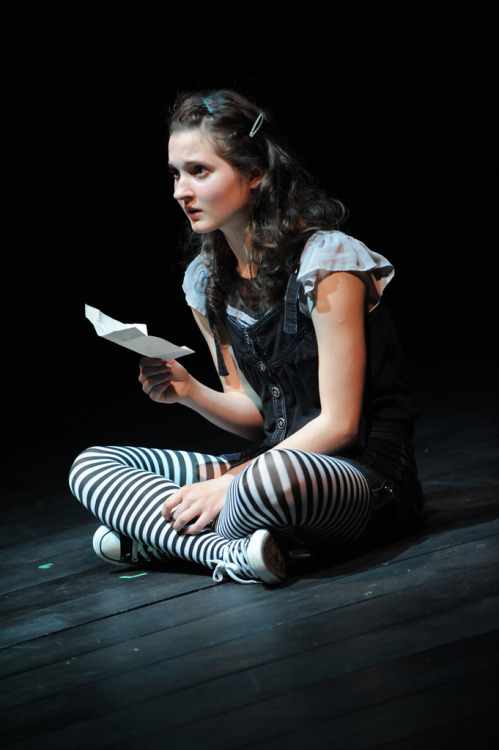
(Ruby Bentall as Alice in the Original Cast of Laura Wade’s “Alice”, photo by Robert Day)
This adaptation is in a modern setting and adapts events from Alice’s adventures in Wonderland as well as including Tweedle-Dum, Tweedle Dee, Humpty Dumpty and some of the Red Queen’s dialogue from Through the Looking-Glass.
The play starts off at a funeral wake, where the Little (not Liddell!) family are in mourning after Alice Little’s brother Joe was killed in a road accident. Whilst Alice sits un-moving in a chair we hear the guests and members of her family discussing the terrible event. As with a lot of adaptations, everything that will appear in Alice’s dream is foreshadowed. From the conversations of the guests -“Time’s a great healer” to the fact that everyone that Alice knows will reappear in her dreamscape. Her annoying cousin will become the Cheshire Cat, her Mum the Queen of Hearts, the two boys from her local school Tweedle-Dum and Tweedle-Dee, ect… I know that a lot of people don’t like this trope but I do, particularly in Alice adaptations.
After her father shows a tape of Joe singing a birthday song, Alice retreats further into herself until the White Rabbit shows up. Unsurprisingly, its Joe. Left alone with only a message- “Go streight to the heart” Alice argues with the mobile phone eating Caterpilllar, now a Wonderland border official and is let into Wonderland. The Caterpillar scene is particularly well handled. Alice is left frustrated and bewildered by the bizarre search techniques- “Any emotional baggage?” and “the Wonderband”, a chorus of randomly singing Wonderland residents.
After all that the play settles into a straightforward structure: Alice meets modernized Wonderland/Looking-Glass Land residents, is confused, and moves on to another confusing encounter, each increasing with strangeness. Act 1 ends on Alice happening to see the Knave steal the Queen of Hearts’s tarts. Act 2 has Alice’s teacher turn up as pompous Humpty Dumpty, her Aunt and Uncle as aging ballroom dancers the Mock Turtle and Gryphon, who teach her the lobster Quadrille, Tweedle-Dum and Tweedle-Dee with a great modern version of “The Walrus and the Carpenter” and of course culminates in the trial scenes.
If you can stand the modern references and variants on Carroll, then there is plenty to enjoy here. I liked this script immensely.
However there is one flaw- towards the end, after she has left Wonderland but is still dreaming, Alice receives guidance from the White Rabbit who explains what everything she saw in Wonderland meant. Apparently its all a metaphor for grief. That would be fine with me, but every single weird event in the play is explained in symbolism by the Rabbit. It veers too much towards the moral structure of the 1999 film for my liking.
So as Alice awakes she discovers that her parents have been looking all over for her, not realising that she was asleep in an armchair all the time. Alice goes outside for the first time in two weeks. In her imagination, she is followed by the celebrating inhabitants of her dream.
I liked this far more than I thought I would, to be honest. Its well written and while it is very much an adaptation, Carroll is not forgotten either as some of his original dialogue and poems find their way, albeit sometimes paraphrased, into the script.